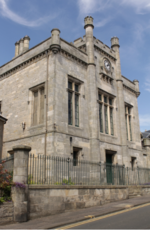Kinghorn

Kinghorn ( ; Scottish Gaelic: Ceann Gronna) is a town and parish in Fife, Scotland. A seaside resort with two beaches, Kinghorn Beach and Pettycur Bay, plus a fishing port, it stands on the north shore of the Firth of Forth, opposite Edinburgh. According to the 2008 population estimate, the town has a population of 2,930.Known as the place where King Alexander III of Scotland died, it lies on the A921 road and the Fife Coastal Path. Kinghorn railway station is on the Edinburgh to Aberdeen and Fife Circle railway lines. Kinghorn only has a primary school, so high school pupils must travel by bus to Balwearie High School in Kirkcaldy. The town's lifeboat station is one of Scotland's busiest – regularly getting called out to all sorts of emergencies in the Firth. Currently stationed at Kinghorn is an Atlantic 85 inshore lifeboat, B-836 "Tommy Niven". The civil parish has a population of 4,201 (in 2011).Burntisland was in the past referred to as Little Kinghorn or Wester Kinghorn.
Excerpt from the Wikipedia article Kinghorn (License: CC BY-SA 3.0, Authors, Images).Kinghorn
Nethergate,
Geographical coordinates (GPS) Address Nearby Places Show on map
Geographical coordinates (GPS)
| Latitude | Longitude |
|---|---|
| N 56.07 ° | E -3.17 ° |
Address
Kinghorn Harbour Holiday Park
Nethergate
KY3 9SY , Pettycur
Scotland, United Kingdom
Open on Google Maps










